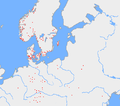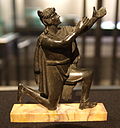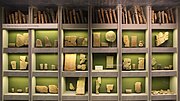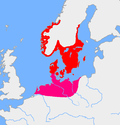The Vimose inscriptions (Danish pronunciation: [ˈvimoːsə]), found on the island of Funen, Denmark, include some of the oldest datable Elder Futhark runic...
5 KB (375 words) - 02:15, 1 September 2024
of West Germanic into Anglo-Frisian, Low German and High German. Vimose inscriptions (6 objects, AD 160–300) Ovre Stabu spearhead (c. 180), raunijaz Thorsberg...
22 KB (2,642 words) - 11:38, 27 December 2024
Elder Futhark (section Scandinavian inscriptions)
Svingerud Runestone (1–250) Vimose inscriptions (6 objects, 160–300) Øvre Stabu spearhead (c. 180), raunijaz Illerup inscriptions (9 objects) Mos spearhead...
33 KB (3,832 words) - 23:58, 23 November 2024
Rune (category CS1 German-language sources (de))
claiming that the earliest inscriptions of the 2nd and 3rd centuries, found in bogs and graves around Jutland (the Vimose inscriptions), exhibit word endings...
68 KB (6,921 words) - 20:23, 28 December 2024
List of languages by first written account (category CS1 German-language sources (de))
Armenian is first attested in the Armenian Bible translation. The Vimose inscriptions (2nd and 3rd centuries) in the Elder Futhark runic alphabet appear...
115 KB (6,850 words) - 04:51, 1 January 2025
o-rune is attested early, in inscriptions from the 3rd century, such as the Thorsberg chape (DR7) and the Vimose planer (Vimose-Høvelen, DR 206).[citation...
21 KB (2,268 words) - 00:31, 29 December 2024
The rune is absent from the earliest Vimose inscriptions, but it is found in the Thorsberg chape inscription, dated to ca. AD 200. The rune may have...
5 KB (436 words) - 23:53, 23 November 2024
earliest inscriptions, e.g. in ansuz (Vimose buckle), þewaz (Thorsberg chape). It was presumably present in the Ovre Stabu spearhead inscription (ca. AD...
24 KB (2,891 words) - 15:55, 25 December 2024
Thorsberg moor (category Articles with German-language sources (de))
are of similar importance as the contemporaneous finds from Illerup and Vimose in Denmark. The moor was excavated in 1858–1861 by a teacher from Flensburg...
7 KB (853 words) - 15:21, 20 November 2024
Germanic peoples (category CS1 German-language sources (de))
Runic inscriptions are found on organic materials such as wood, bone, horn, ivory, and animal hides, as well as on stone and metal. Inscriptions tend to...
164 KB (20,237 words) - 22:30, 1 January 2025
translating to "Battle-goddess") and probably also in an inscription from around 200 CE on a buckle from Vimose that reads a(n)sau wīja ("I dedicate this to the...
36 KB (3,992 words) - 11:45, 27 December 2024
Ancient text corpora (category CS1 German-language sources (de))
Illerup and Vimose, in Germania 64, 1986, 75ff Peust 2000, pp. 259. Bernand, E.; Drewes, A.J.; Schneider, R. (1991). Recueil des inscriptions de l'Ethiopie...
47 KB (5,403 words) - 08:13, 24 August 2024
Castle Gundestrup cauldron, c. 200 BCE-300 CE, National Museum of Denmark Vimose Comb, c. 160 CE, National Museum of Denmark Accounts such as Grímnismál...
35 KB (4,291 words) - 06:41, 18 October 2024
early runic inscriptions (specifically the Vimose inscriptions, dated to the 2nd century CE, as well as the non-runic Negau helmet inscription, dated to...
131 KB (12,234 words) - 13:44, 1 January 2025
reflects the Common Germanic stage. The Vimose inscriptions include some of the oldest datable Germanic inscriptions, starting in c. 160 AD. The earliest...
94 KB (9,575 words) - 07:54, 3 January 2025
goddess") that appears on a Roman inscription from Tongeren, with a second early attestion on a Runic belt-buckle found at Vimose, Denmark from around 200 CE...
128 KB (15,974 words) - 21:56, 23 December 2024











